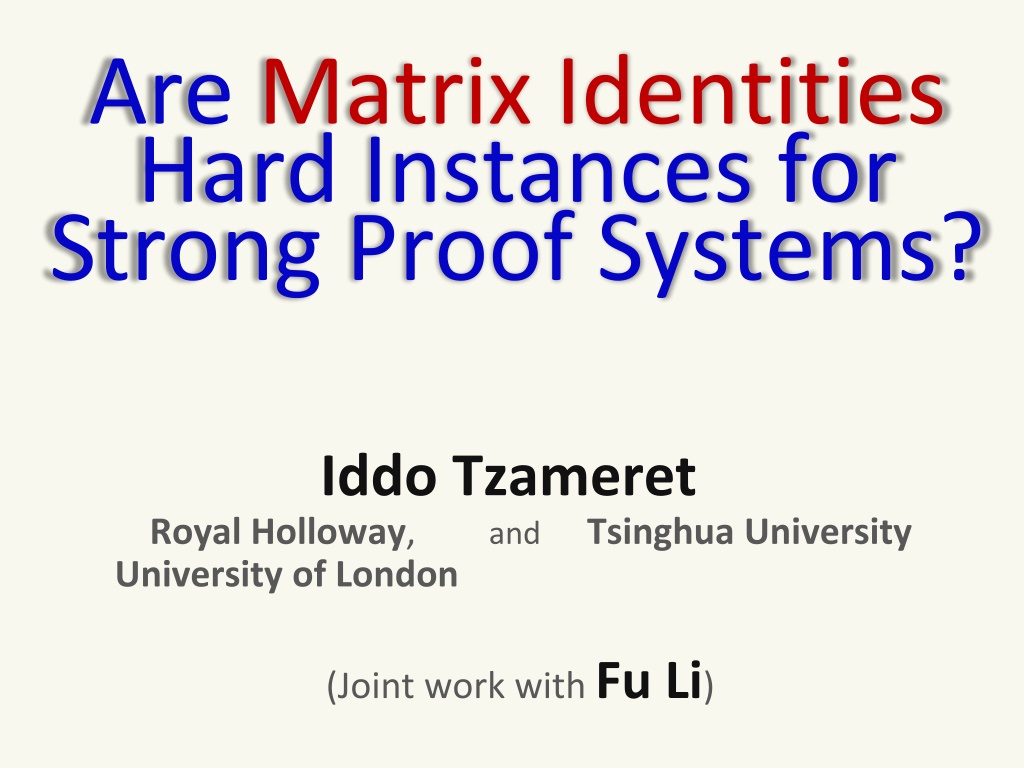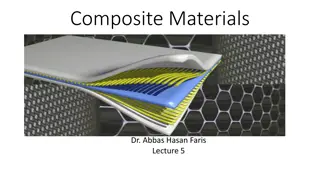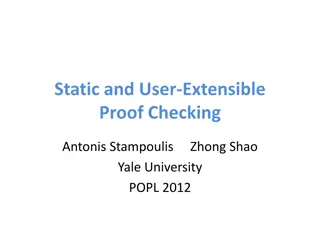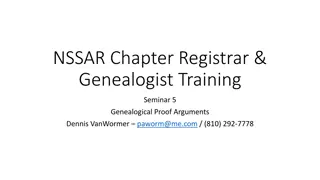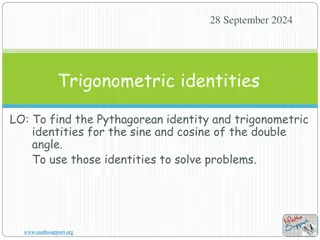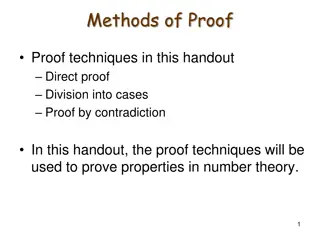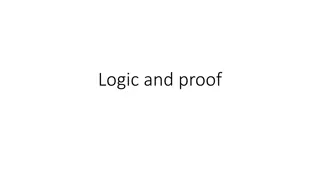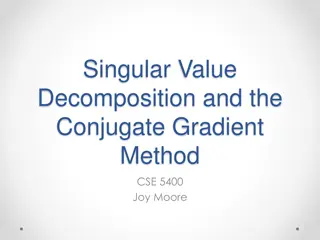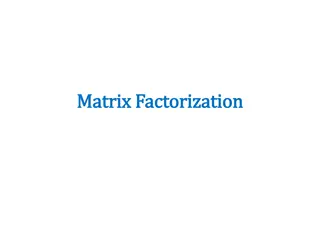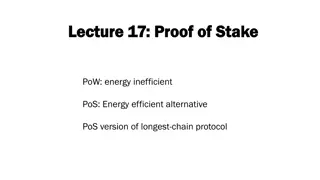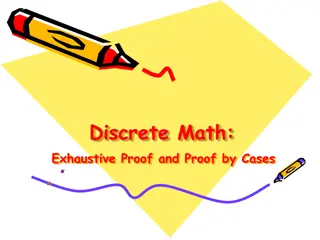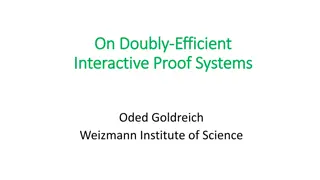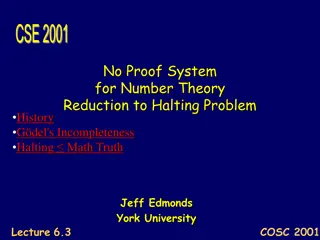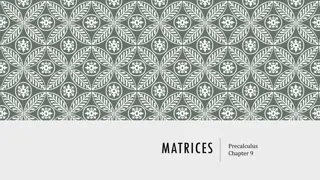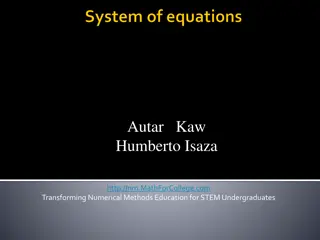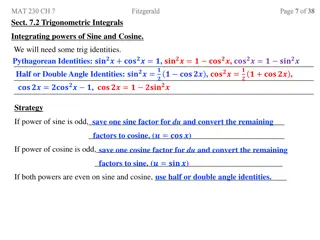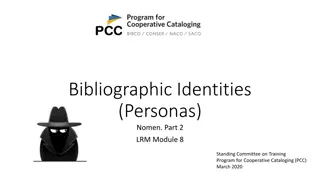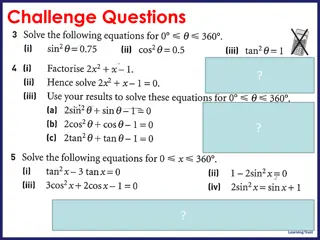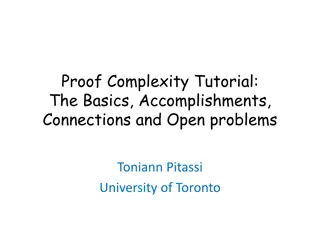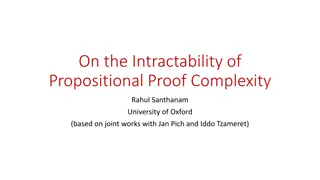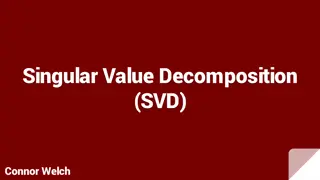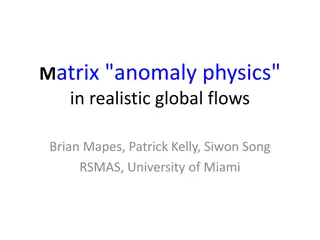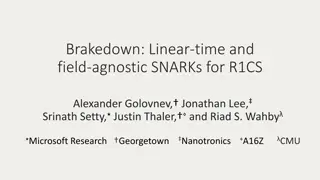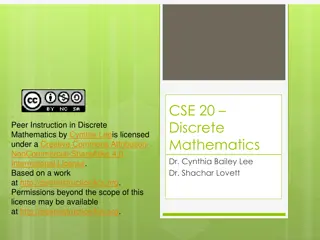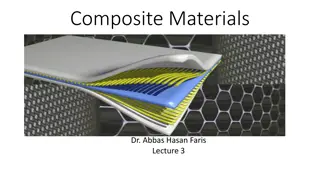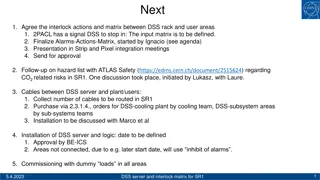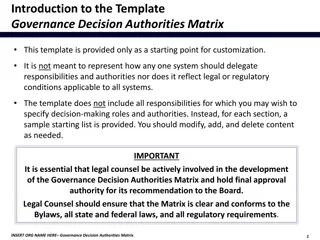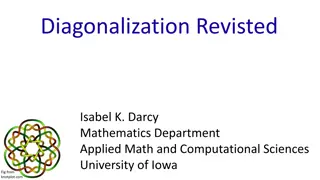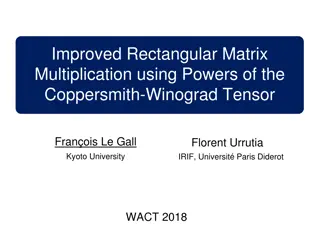Exploring Matrix Identities in Strong Proof Systems
This study delves into the complexity of matrix identities as potential challenges for robust proof systems. Through new algebraic techniques, the research aims to propose and analyze non-commutative polynomial identities over matrices, shedding light on lower bounds and conjectures for strong arithmetic and propositional proof systems.
Download Presentation

Please find below an Image/Link to download the presentation.
The content on the website is provided AS IS for your information and personal use only. It may not be sold, licensed, or shared on other websites without obtaining consent from the author. Download presentation by click this link. If you encounter any issues during the download, it is possible that the publisher has removed the file from their server.
E N D
Presentation Transcript
Are Matrix Identities Hard Instances for Strong Proof Systems? Iddo Tzameret Royal Holloway,andTsinghua University University of London (Joint work with Fu Li)
STRONG PROOF SYSTEMS: CURRENT AFFAIRS Best lower bound: (n2) No non-trivial conditional lower bounds No non-explicit lower bounds No hard candidates (almost) 2
WE PROPOSE New algebraic technique to lower bound strong arithmetic or propositional proof systems (e.g. Extended Frege) Identify new natural hard candidates 3
IN A NUTSHELL Propose matrix identities as hard candidates for strong proof systems Matrix identity: (non-commutative) polynomial that vanishes over matrices of a given dimension Give some lower bounds Formulate a natural conjecture to realize fully our approach 4
(Commutative) polynomials Formal sum of (commutative) monomials (order of multiplication doesn t matters). Example: The commutator [X,Y]:=XY-YX is the zero polynomial 6
Tautologies Logical connectives: , , XOR, (AND,XOR andEquivalent, resp.) True functional identities over GF(2): 1+(1+x)(x) =1+x+x2=1 Polynomial identities Formal commutative polynomial identities 7
Non-commutative polynomials: Formal sum of non-commutative monomials (order of multiplication matters). Example: The commutator XY-YX is a non-zero polynomial 8
MATRIX IDENTITIES Matd(?) := d d matrices over field ?. Assume ? is of characteristic 0 (e.g. rationals) A matrix identityf(x1, ,xn) ofMatd(?)is a non-commutative polynomial over x1,...,xn that is zero for all assignments of matrices: for all vectors a of d d matrices: f(a)=0 9
MATRIX IDENTITIES Example: xy-yx is a nonzero non- commutative polynomial, but it's not an identity of Matd(?) (when d>1): 10
MATRIX IDENTITIES 1 x 1 matrix identities (commutative) polynomial identities 2 x 2 Matrix identities Non-commutative polynomial that is always zero for 2x2 matrices f(x1, ,xn)=0, for all x1, ,xn in Matd(F) 3 x 3 Matrix identities 4 x 4 Matrix identities Chain 1x1 matrix identities 2x2 matrix identities 3x3 matrix identities 11
BIRDS EYE VIEW OF OUR APPROACH 12
Extended Frege p Arithmetic proofs (Hrubes & T. 09, 12) p Mat2(F) proofs p Mat3(F) proofs We identify a new hierarchy within Extended Frege (algebraic, not circuit-based hierarchy) Conditional (n2d) lower bounds in this hierarchy Conjecture: for encoded n x n matrix identities, Matn(F) proofs p-equivalent to arithmetic proofs. 14
ARITHMETIC PROOF SYSTEMS 15
ARITHMETIC PROOFS Establish (commutative) polynomial identities Proof-lines: equations between algebraic circuits Axioms: polynomial-ring axioms Rules: Transitivity of = ; +,x introduction, etc. Circuit-axiom: F=G, if F and G are identical when the circuits are unwinded into trees Rules: Axioms: 16
ARITHMETIC PROOFS x=x reflexivity axiom 2 3=6 field identities axiom product rule commutativity axiom 3x 2=2 3x 2 3x=6x transitivity 3x 2=6x 17
ARITHMETIC PROOFS By Rekchow s theorem: Over GF(2) (and plausibly over the integers) arithmetic proofs are also propositional proofs of the translated tautology 18
PROOF SYSTEMS FOR Matd(?) Identities 19
BASIS OF MATRIX IDENTITIES A finite basisB={g1,...,gm} of the identities of Matd(F) is a set of non-commutative polynomials that generate all possible identities of Matd(F) (we can also substitute variables x1,..,xn by polynomials): Every identity f of Matd(F) can be written as: for some polynomials qi s, ti s and pi s. 20
Matd(?) ARITHMETIC PROOFS FOR Simply replace the commutativity axiom Axioms: Basis of Matd(?) identities By Kemer 87 there is always a finite basis 21
LOWER BOUNDS FOR Matd(?) PROOFS 22
COMPLEXITY MEASURE QB(f)=min k such that: I.e., how many substitution instances of generators from basis B needed to generate an identity of Matd(?) ? 23
OUR LOWER BOUND Thm [Fu and T. 14]: For every d>2, and every finite basis B of the identities of Matd(?) , there exists a degree 2d+1 polynomial identity f with n variables, such that QB(f)= (n2d). Proof idea: 1. Use Amitsur-Levitzki Theorem (1950); 2. Counting argument; Extension of Hrubes ( 11) 3. Use other structural properties of Matd(?) identities . Generalize Hrubes( 11) for d=1 It s open to find bases for Matd(?) ( the Specht problem ) 24
COROLLARY Minimal number of basis generators- instances needed to generate an identity of Matd(?) is a lower bound on basis axiom-instances in Matd(?)-proofs Corollary: (n2d) lower bound on number of lines in Matd(?)-proofs. 25
TOWARDS ARITHMETIC PROOFS LOWER BOUNDS 26
Extended Frege p Arithmetic proofs (Hrubes & T. 09, 12) p Mat2(F) proofs p Mat3(F) proofs Number of lines (n2d) lower bounds in this hierarchy Conjecture: for encoded n x n matrix identities, Matn(F) proofs p-equivalent to arithmetic proofs. 27
TRANSLATING MATRIX IDENTITIES Matrix identity f of Matd(F) set of d2 (commutative) Example: X Y=I polynomial identities over variables X. Treat X,Y as 2x2 matrices: Now can use arithmetic proofs to prove the four equations ! 28
CONJECTURE Conjecture: For any fixed d, and a circuit equation G=0 computing a matrix identity g=0, the minimal size of an arithmetic proof of the d2 corresponding identities of G=0is (QB(g)). In other words: proving matrix identities of Matd(?) entry-wise cannot be faster than proving them using substitution instances of the generating sets of Matd(?) . 29
Intuition: The following are equivalent for proving matrix identities: Reason with variables X1, . . . ,Xn that range over matrices; Reason with variables that range over the entries xijk (for i,j,k [n]) of the matrices X1, . . . ,Xn 30
EXPONENTIAL LOWER BOUNDS We can hope for even exponential lower bounds: the dimension d increases with n. 31
CONCLUSIONS 32
Extended Frege p Arithmetic proofs (Hrubes & T. 09, 12) p Mat2(F) proofs p Mat3(F) proofs We identify a new hierarchy within Extended Frege (algebraic, not circuit-based hierarchy) Conditional (n2d) lower bounds in this hierarchy Conjecture: for encoded n x n matrix identities, Matn(F) proofs p-equivalent to arithmetic proofs. 33
THANKS FOR LISTENING! QUESTIONS, COMMENTS, SUGGESTIONS, OBJECTIONS?
WHATS THE CONNECTION? Observation (Hrubes 11): The minimal arithmetic proof of f=g >= Q1(\hat f-\hat g), where \hat f is the noncommutative poly computed by circuit f. Proof: By induction on number of lines t in proof. Base: t=1. f=g is an axiom. If f=g not the commutativity axiom, say h+0=h, then \hat (h+0)-\hat h =0\in F<X>. Hence Q1(0)=0. Otherwise, f=g is the axiom uv=vu, for u,v circuits, and so Q1(uv-vu)=1. 36
Complexity measure: how many substitution instances of generators are needed to generate an identity for Matd[F] ? The case of d=1: Let Q1(f) be the minimal number of substitution instances of commutators [x,y] needed to generate identities of Mat1[F]. i.e., min k such that f in I<[t1,t 1], ,[tk,t k]>, for some t s in F<X>. Example: Q1(sum_{i,j\in n} xixj ) = 1 sum_{i,j\in n} xixj = (x1+ +xn)*(x1+ +xn) 37
THE LOWER BOUND PROOF 38
What are the hard identities f ? We call it the s-formulas: where For some n fixed fi s: 39
Well only show that to generate nfis: f1, ,fn by s2d polynomials we need (n2d) many generators: Q(f1, ,fn)= (n2d) (To combine them into we need more work.) 40
BY COUNTING (total # of n-tuples of f1, ,fn) vs. (total # of n-tuples f1, ,fn we can generate with q s2d generators) (We show that q= (n2d).) Lemma: For any d and polynomials p1, ,pn: 41
Thus we can assume w.l.o.g. that the substitutions in the generators variables are linear forms: 42
Recall: So, total # of possible n-tuples of fi s: (for each i=1,..n choose which of the cj s in fi are 1). 43
total # of n-tuples f1,,fn we can generate with q s2d-generators: choose 2d x q linear forms x choose q field elements for coefficients of linear combination: We get: Assume field is finite. The other case can also be handled. implying: Q.E.D. 44
LEMMA Lemma: For any d and polynomials p1, ,pn: 1. deg > d monomials in pi not counted in LHS 2. Property of s2d(x1,..,x2d): assigning a constant to a variable makes it 0. Thus: Degree 0 monomial in pidoesn t contribute to LHS; Degree >1 monomial in pi can contibute to LHS only if it multiplies a constant in some pj, j j. Hence, we get 0 again. 45
THE ALGEBRAIC PROBLEM Let F<X> be the ring of noncommutative polynomials over variables x1,x2, i.e., every polynomial is a formal sum of noncommutative monomials with coefficients from the field F. E.g., the commutator [x1,x2]:= x1x2 x2x1 is not the zero polynomial. 46
THE ALGEBRAIC PROBLEM Let A be a (not necessarily commutative, but associative) F -algebra. E.g.: the dxd matrix algebra Matd( ). An identity of A is a noncommutative polynomial f(x1,..,xn) in F<X>,, where for all vectors a from An, f(a)=0. E.g.: x1x2 x2x1 is an identity of Mat1( F ) (but not of Matd( ) if d>1) 47
Consider the set of identities over Matd[F]. Kemer 87: Identities of Matd[F] can be generated (in the two-sided ideal) by substitution instances of a finite set G of polynomials g1 gc in F<X I.e., every identity f in F<X> over Matd(F) can be written as: for some polynomials Qi s, ti s and Pi s in F<X . 48
Example for d=1 case (Mat1[F]): All identities of Mat1[F] can be generated by substitution instances of a single polynomial: the commutator [x,y]=xy-yx : f is an identity of Mat1[F] iff f in <[x_i,x_j]: i neq j in N (all ideals are two sided ideals). 49
Complexity measure: how many substitution instances of generators are needed to generate an identity for Matd[F] ? The case of d=1: Let Q1(f) be the minimal number of substitution instances of commutators [x,y] needed to generate identities of Mat1[F]. i.e., min k such that f in I<[t1,t 1], ,[tk,t k] , for some ti s in F<X>. Example: Q1(x1x3-x3x1+x2x3-x3x2)=? =1 since: (x1+x2)x3-x3(x1+x2)=x1x3-x3x1+x2x3-x3x2 50
